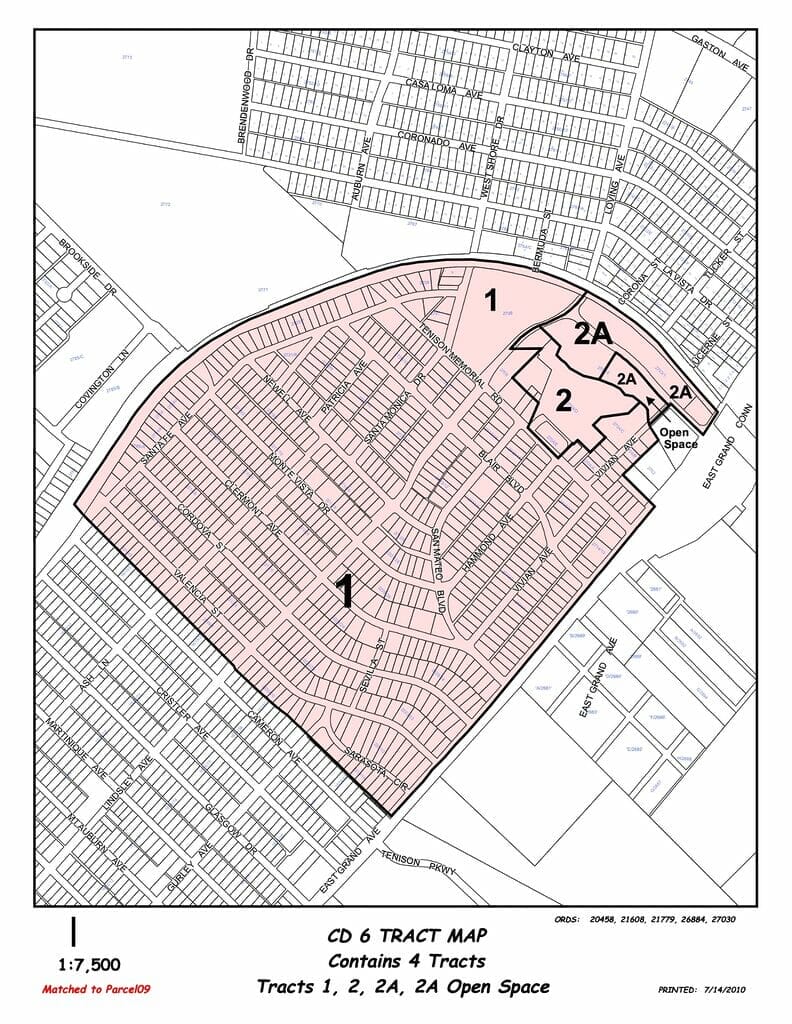Hollywood / Santa Monica Neighborhood Conservation District
Important
ANY construction or remodeling of the outside of your home requires a Conservation District Work Review Form from the City of Dallas.
This form is in addition to any other permits (such as building permits) required by the city. In a Conservation District, the guidelines are city law, and violations result in the city enforcing the Conservation District Ordinance with work stoppage or fines. The process can be completed online prior to beginning work on your home.
Before starting any exterior remodeling, repairs, or improvements on your home, ensure you’ve submitted the Conservation District Work Review Form.
Remember, in a Conservation District, the guidelines are city law. Any violations can lead to the city enforcing the Conservation District Ordinance, which may result in a work stoppage or fines. Please familiarize yourself with the ordinance by downloading a copy that can be found here.
Acquiring the Conservation District Work Review Form is straightforward and can be processed by mail. When planning exterior work, send a detailed description of your project, accompanied by photos of the current state and sketches of your proposed changes to:
Trevor Brown
Chief Planner, Conservation Districts
Dallas, Texas 75203
Phone: +1 (214) 948-4458
Email: vog.sallad@nworb.rovert
For additional resources and helpful links, check out the sidebar on the right.
Resources
-
Conservation District Work Review Form
Conservation District submittal requirements application. This also contains a checklist and clearly outlines the required documents.
-
Project Application Process
A high-level overview of the project application process.
-

Visit the City of Dallas Planning & Urban Design Website
A good resource for understanding the process and understanding the requirements.
Ordinances + District Map
-
Ordinance #21608 (03/09/1993)
Conservation District #6 - Hollywood Heights/Santa Monica -
Ordinance #27030 (12/12/2007)
Amendment to Conservation District #6
-
Ordinance #27423 (12/10/2008)
Amendment to Conservation District #6, Tract IIA "Open Space"
-
Conservation District #6 Map
View the map that represents the Conservation District.
Top 10 Restricted Activities
-
01
Improper Porch Enclosures
-
02
Painting of Exterior Brick Veneer and Paint Colors
-
03
Installation of Skylights
-
04
Asphalt, Gravel, or Circular Driveways
-
05
Front/Side Yard Fence Height and Required Setback
-
06
Carports not in the Backyard
-
07
Removal of Original Stained Glass
-
08
Metal Roof Materials
-
09
Window and Door Replacement
-
10
Retaining Walls
Conservation District Submission Guidelines
Remodeling, Additions, and New Construction
Submit two sets of plan drawings that include the following:
- Elevations labeled by cardinal directions and scaled plan drawings that clearly indicate proposed alterations or additions and outline existing and proposed work.
Note: until further notice, an 11″ by 17″ set of plans must be provided in addition to the complete sets - A site plan detailing any location and dimensions of new construction or additions and all setbacks.
- A lot survey displaying
- the dimensions of your proposed changes
- the location and dimensions of any existing structures
- and all setbacks.
- Photographs of the house and other structures on the property where work is planned, capturing existing conditions from all relevant angles.
- If altering the existing slope, include a grading plan. A detailed, scalable drawing of the proposed foundation indicating the finished grade’s location at a minimum scale of ½ inch = 1 foot.
Windows
Provide photographs of all windows to be replaced and manufacturers’ images of proposed replacements, including details like dimensions, material, and window types. The image should clearly show the dimensions of the windows, the number of lites/divisions, whether muntins are expressed outside of the class, window material, and window types (e.g., double hung, casement, etc.). Indicate on elevations if window openings will be enlarged or reduced in size.
Roofing
Type of roofing material on the structure currently (e.g., clay tile, comp. shingles), proposed roofing material (e.g., clay tile, comp. shingles), and brand name of proposed roofing material and color (e.g., GAF, Timberline in Weathered Wood).
Painting
Paint color chip required. The color chip should show the brand, color number, and name (e.g., Sherwin-Williams. SW 6359, Beige).
Pools
Provide a cross-sectional view of the length and the width of the pool/spa, showing the height (in inches) above grade for any element of the pool and spa. Include an 8.5″ by 11″ color image of how the finished pool/spa will look.
Fencing
Provide a property survey that shows the location of existing and proposed fencing, living and proposed materials, and existing and proposed fence heights.
Note: Submittal requirements for fences may vary according to Conservation District regulations; consult a Conservation District Planner for specifics. Additional drawings and information may be required to complete the project review. Minimum scale of ⅛ inch = 1 foot on all plans and elevations unless approved by a Conservation District Planner. Plans should not be reduced and must be to scale to verify measurements. If required, sections or detail drawings should have a minimum scale of ½ inch = 1 foot.
Eligibility for Conservation District Designation
The Hollywood/Santa Monica neighborhood is nestled in the rolling hills of East Dallas. In the 1920s, it was on the city limits – the last neighborhood one passed through before leaving Dallas. It is one of Dallas’s most stable and intact areas in which a large concentration of period cottage-styled homes has survived and have been maintained in almost vintage condition. Located between Lakewood and the Samuel/Tennison Parks, the neighborhood has easy access to Downtown, White Rock Lake, Interstate 30, and Fair Park. Some parts of the area enjoy splendid hilltop views of Downtown, while others are afforded incredible creek and park views.
Background and Feasibility
In April 1988, the City Council authorized the Department of Planning and Development to undertake a feasibility study for a Hollywood/Santa Monica conservation district. The Santa Fe Railroad, East Grand Avenue, and Valencia Avenue generally bound the area.
After several meetings with the residents to discuss the issues and concerns about a conservation district designation, a feasibility study was undertaken to determine if the area qualified. The findings of that study concluded that the area did qualify because:
- The proposed boundaries contained numerous block faces with contributing and significant structures of architectural value.
- The zoning and land use patterns were very consistent.
- There was strong property owner support for the concept.
- The proposed area is stable and has a distinctive atmosphere and character, which can be conserved by protecting its architectural and cultural attributes.
Historical Architectural and Cultural Attributes
The area was developed in the 1920s and 1930s along with other similar areas like Lakewood, the “M” Streets, Oak Cliff, Oak Lawn, and the Park Cities. Dallas’ middle classes occupied these homes and were indicative of their accomplishments as professionals, teachers, merchants, and business people. The cottage style is a simple construction with flourishes of elegant detailing borrowed from other styles—usually Tudor—and built of brick with stone or stucco accents. While there are many individual examples of outstanding cottage architecture in the area, the fact that an entire neighborhood of this period style remains is significant. The neighborhood also has examples of Colonial Revival, Neo-Classical, Spanish, Neo-Gothic Revival, and French styles.


